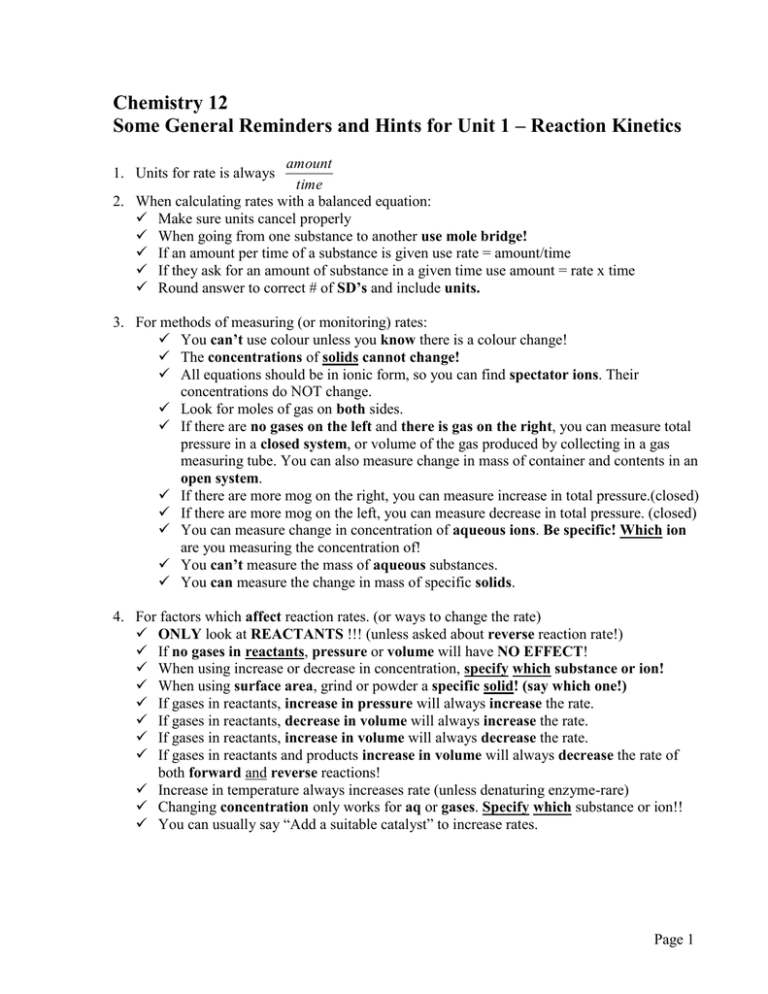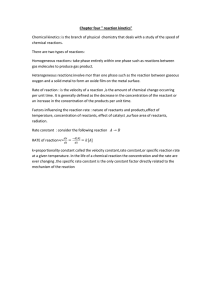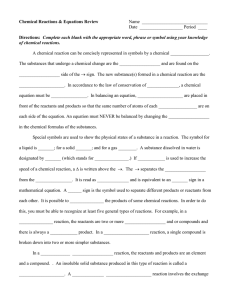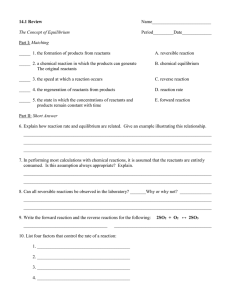Chemistry 12
advertisement

Chemistry 12 Some General Reminders and Hints for Unit 1 – Reaction Kinetics amount time 2. When calculating rates with a balanced equation: Make sure units cancel properly When going from one substance to another use mole bridge! If an amount per time of a substance is given use rate = amount/time If they ask for an amount of substance in a given time use amount = rate x time Round answer to correct # of SD’s and include units. 1. Units for rate is always 3. For methods of measuring (or monitoring) rates: You can’t use colour unless you know there is a colour change! The concentrations of solids cannot change! All equations should be in ionic form, so you can find spectator ions. Their concentrations do NOT change. Look for moles of gas on both sides. If there are no gases on the left and there is gas on the right, you can measure total pressure in a closed system, or volume of the gas produced by collecting in a gas measuring tube. You can also measure change in mass of container and contents in an open system. If there are more mog on the right, you can measure increase in total pressure.(closed) If there are more mog on the left, you can measure decrease in total pressure. (closed) You can measure change in concentration of aqueous ions. Be specific! Which ion are you measuring the concentration of! You can’t measure the mass of aqueous substances. You can measure the change in mass of specific solids. 4. For factors which affect reaction rates. (or ways to change the rate) ONLY look at REACTANTS !!! (unless asked about reverse reaction rate!) If no gases in reactants, pressure or volume will have NO EFFECT! When using increase or decrease in concentration, specify which substance or ion! When using surface area, grind or powder a specific solid! (say which one!) If gases in reactants, increase in pressure will always increase the rate. If gases in reactants, decrease in volume will always increase the rate. If gases in reactants, increase in volume will always decrease the rate. If gases in reactants and products increase in volume will always decrease the rate of both forward and reverse reactions! Increase in temperature always increases rate (unless denaturing enzyme-rare) Changing concentration only works for aq or gases. Specify which substance or ion!! You can usually say “Add a suitable catalyst” to increase rates. Page 1 5. Get all the graphs in this unit straight in your mind: Graphs of concentration vs. time for reactants and products Graphs of rate vs. time for reactants and products Kinetic energy distributions (where is KE, # of molecules, Ea, Area under curve) Potential energy diagrams (uncatalyzed and catalyzed rx., forward, reverse rx) Use slope of Amount vs. Time graphs to calculate rate (intervals) Graph of rate vs. Time 6. For PE diagrams: Read the question, are they asking for forward or reverse rx??? Are they asking for catalyzed or uncatalyzed or both??? Are they asking for Ea or Energy of the Activated Complex (different!) H is just net difference in energy between reactants and products. Are they asking for forward or reverse? Ea is always positive Higher PE means more unstable and lower KE Lower PE means more stable and higher KE Lower PE species have stronger bonds 7. For Nature of Reactants affecting rates Look for covalent bonds that need to be broken (CH compounds, diatomic gases) ONLY look at reactants Aqueous reactants with no bonds to break are always fastest Heterogeneous reactions are usually slower (especially with solids) 8. For Reaction Mechanisms: CIA (X-files) Slowest step if RDS Only speeding up slowest step (RDS) will affect overall rate. Don’t get overall reaction mixed up with steps Recognize intermediates and catalysts Make sure atoms and charges are balanced! Formula for Activated Complex in a step-Take all the atoms and charges in reactants and group them all into ONE species! (Use subscripts and charges!) Increasing concentration of a reactant in a step will increase the rate of that step. To find reactants and products, you must figure out the overall reaction! 9. Page 2





